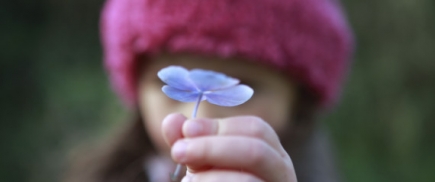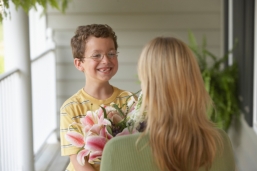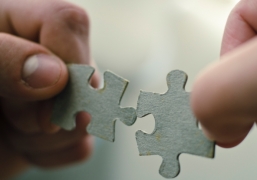Three Ways to Bring More Kindness to Your Life
One of the best ways to increase our own happiness is to do things that make other people happy. In countless studies, kindness and generosity have been linked to greater life satisfaction, strongerrelationships, and better mental and physical health—generous people even live longer.

What’s more, the happiness people derive from giving to others creates a positive feedback loop: The positive feelings inspire further generosity—which, in turn, fuels greater happiness. And research suggests that kindness is truly contagious: Those who witness and benefit from others’ acts of kindness are more likely to be kind themselves; a single act of kindness spreads through social networks by three degrees of separation, from person to person to person to person.
But just because we have the capacity for kindness, and reap real benefits from it, doesn’t mean that we always act with kindness. We may be too busy, distracted, or wrapped up in our own concerns to pay close attention to others’ needs or actively seek out opportunities to help. Or we’re just out of practice: Researchers have argued that kindness is like a muscle that needs to be strengthened through repeated use.
How do we strengthen kindness? Researchers have identified a number of effective exercises, and many of them are collected on the Greater Good Science Center’s new website, Greater Good in Action (GGIA), which features the top research-based activities for fostering happiness, kindness, connection, and resilience.
Here I highlight GGIA’s 10 core kindness practices, grouped into three broad categories.
1. How to Cultivate Feelings of Kindness

Kind behavior comes more naturally when we’re feeling a sense of compassion and connection with others. This first set of practices focuses on cultivating these feelings.
The Feeling Connectedpractice involves thinking about a time when you felt a strong connection to another person—through a meaningful conversation, say, or by experiencing a great loss or success or historic event together—and describing that experience in writing. A 2011 study led by researcher Louisa Pavey in the United Kingdom found that participants who completed this exercise reported increases in feelings of concern for others and stronger intentions to carry out a number of generous acts over the next six weeks, such as giving money to charity and helping a stranger in need.
How does this practice increase kindness? Research suggests that feeling connected to others satisfies a fundamental psychological need to belong; when this need is unmet, people are more likely to focus on their own needs rather than caring for others.
Similar to Feeling Connected is the Feeling Supported practice, which involves thinking about the qualities of the people you turn to when you’re distressed, then recalling a time when you were comforted by one of them. A 2005 study led by Mario Mikulincer, dean of the school of psychology at the Interdisciplinary Center Herzliya in Israel, found that people who completed this writing exercise, compared with those who wrote more generically about a colleague or acquaintance, subsequently reported greater compassion and willingness to help a person in distress. This simple practice is powerful because it increases “attachment security,” a state that involves feelings of trust and comfort and is especially helpful when we’re feeling threatened or insecure. It can also remind us of the kinds of qualities we want to embody when kindly supporting others.
Another excellent way to tap into feelings of compassion and concern for others is to take an Awe Walk, which involves going for a stroll somewhere that seems vast and perspective-shifting, and makes us feel connected to something greater than ourselves. In a 2015 study led by Paul Piff, then a researcher at the University of California, Berkeley, some participants stood in a grove of towering eucalyptus trees and gazed up for just one minute; other participants looked away from the trees, at a building. The tree gazers were subsequently more likely to help someone in need and less likely to feel that they were superior to others.
Finally, you can try a Compassion Meditation. This simple—though not necessarily easy—technique involves paying attention to your breathing as you extend feelings of goodwill toward a loved one, yourself, a neutral person, and even an enemy. Results of a 2013 study led by Helen Weng, then at the Center for Investigating Healthy Minds at the University of Wisconsin, Madison, showed that participants who performed the compassion meditation for two weeks demonstrated more generous behavior, donating more money to a victim of unfair treatment, and they also showed greater activity in brain regions associated with understanding the suffering of others and regulating emotions in response to pictures of suffering. (You can find audio of a guided compassion meditation on the GGIA website, along with the script for this meditation.)
2. How to Boost the Happiness We Get from Kindness

Another way to increase the amount of kindness we perform over the long terms sounds simple: make a concerted effort to perform more kind and generous acts in the short term.
Intentionally practicing kindness in our everyday lives, even on days when we’re not in a particularly generous mood, can go a long way toward turning kindness into a habit. That’s largely because of the way kindness breeds happiness: The good feelings serve to reinforce our kind acts and make us more likely to want to perform them in the future.
Practicing Random Acts of Kindness is a good place to start. This practice involves performing five acts of kindness in one day and then writing about the experience. They can be anything from bringing a meal to a sick friend to giving up your seat on the bus to donating blood to buying a coffee for the person in line behind you at a cafe. For ideas, consider acts of kindness that you’ve witnessed or received in the past, and check out this Buzzfeed list of 101 suggestions. Random acts of kindness not only lift our spirits in the moment; they also have the potential to alter the way we feel about ourselves and increase healthy forms of self-esteem.
Research suggests that not all acts of kindness are created equal, however. Many factors can influence whether and how these acts bring us psychological benefits. The Making Giving Feel Goodpractice outlines three strategies that can maximize the positive effects of generosity.

The first strategy is to make giving a choice. Research suggests that when we feel obligated to give—such as when we feel cornered by an aggressive request—we are less likely to enjoy it. It’s important to give yourself the option to say no, and to give others the same option when requesting help. The second strategy is to make a connection with the recipient of your kindness—for example by taking a colleague out to lunch rather than just giving a gift certificate. The third strategy is to take the initiative to learn about the impact of your generosity, which can elicit contagious feelings of joy. For example, see this video of a bone marrow donor meeting the little girl whose life he saved.
3. How to Inspire Kindness in Others
It’s important to find ways to boost your own kindness. But arguably the greatest good we can do in the world comes from finding ways to increase kindness in others. That’s what the next set of practices are designed to do.
On GGIA, we provide three research-based strategies for educators, parents, and leaders of all kinds to help others overcome barriers to kindness and generosity. The first is to create Reminders of Connectedness in a home, office, or classroom. These reminders can be something as simple as a quote evoking shared goals, words like “community,” or a picture conveying warmth or friendships.
The second involves Putting a Human Face on Suffering: Being able to identify distinct, specific victims of a problem—and learning about their personal stories—can make that problem more vivid, strike an emotional chord, and thus motivate people to help.
The third, Shared Identity, involves forging a sense of common humanity across group boundaries. Reminding people to see the basic humanity that they share with those who might seem different from them can help overcome fear and distrust and promote cooperation. Even small similarities, like appreciating sports, can foster a greater sense of kinship. (An overview of these three strategies is also provided in the Eliciting Altruism practice.)
Finally, the practice for Encouraging Kindness in Kids offers four specific techniques to bring out children’s natural propensity for kindness and generosity. These techniques include avoiding external rewards for kind behavior, so that kids get to experience the feeling that kindness is its own reward, praising kids’ character instead of their behavior so they come to see kindness as an essential part of who they are, and modeling kindness in your own behavior, since actions tend to speak louder than words when it comes to nurturing generosity.
Becoming a kinder person—and nurturing kindness in your children and students—isn’t something that happens overnight. It takes practice to turn your best intentions into concrete actions. We hope the kindness exercises on Greater Good in Action provide an effective way to start building that habit today.
This article is printed here with permission. It originally appeared on Greater Good, the online magazine of the Greater Good Science Center (GGSC). Based at UC Berkeley, the GGSC studies the psychology, sociology, and neuroscience of well-being, and teaches skills that foster a thriving, resilient, and compassionate society.


On Apr 7, 2016 Jas wrote:
Being kind to others just so you can feel happy is really selfish. I'm never going to be nice to someone for my own sake.
Post Your Reply